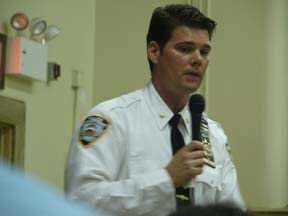
By Hazel Lodevico, Independent Newspapers
In 1994, a two-time convicted sex offender lured 7-year-old Megan Kafka into his New Jersey home with the promise of seeing a puppy. Instead, she was raped and killed by the man who had been convicted of sexually assaulting two other children.
After that brutal crime, New Jersey became the first state to pass Megan's Law, which mandates for active community notification, ensuring the community will be made aware of the presence of convicted sex offenders who may pose a risk to public safety.
The federal law requires all 50 states to release information to the public about known convicted sex offenders when it is necessary to protect their safety but does not mandate active notification.
In 2006, Gov. Janet Napolitano signed several laws advocating for rigorous tracking of registered sex offenders and placed further restrictions on where sex offenders may live after their release from prison.
As sex offenders move into parts of the Southeast Valley, attracted by low-income, affordable housing, law enforcement officials say they take extra measures to notify nearby residents of a released sex offender now living in their neighborhood.
With roughly 200 registered sex offenders in the Southeast Valley, about 60 of those addresses cannot be verified, according to the Department of Public Safety web site.
Arizona statutes
Arizona statutes on sex offenders are standard for police departments across the state, according to Lt. Paul Chagolla of the Maricopa County Sheriff's Office
Lt. Chagolla said sex offenders must register with the county sheriff within 10 days after conviction or within 10 days after entering and remaining in any county in Arizona.
At the time of registration an offender must sign a written statement including all information required by the Director of the Department of Public Safety including name and most current place of residency.
If a registered sex offender changes his or her address or name, he or she must inform the sheriff's office in person and in writing of the new address or new name within 72 hours.
The same also goes for out-of-state sex offenders who move to Arizona.
If the offender moves out of Arizona, the sheriff of the county from which he or she moves must advise the local law-enforcement agency in the new jurisdiction.
Violation of registration requirements is a Class 4 felony and the offender will be arrested, Lt. Chagolla said.
According to Detective Phil Quitana of Mesa Police Department's sex offender notification unit, sex offenders are usually closely monitored by their probation officer. However, identifying out-of-state sex offenders who move into Arizona can be difficult if that offender is not assigned a probation officer.
In that case, a sex offender may not be immediately identified unless he or she is stopped for another offense such as a routine traffic stop, Detective Quitana said. However, that number is minute since roughly 90 percent of released sex offenders are on probation, Detective Quitana said.
Local law enforcement may also continually drop by the offender's home to verify the person is still living at the address or that they are not being harassed by the local community.
"People do need to realize that these are people who have done their time and now need to return to society," Detective Quitana said. "We try to build a rapport with these individuals. We don't want them to go underground."
While all police departments or sheriff's offices are also required to notify the community of a sex offender, only Level 2 and Level 3 sex offenders - some of the most dangerous convicted offenders - are included in the notifications.
Much of the warnings come in the form of fliers and media announcements.
According to Jennie Lewis, Apache Junction Police Department Crime Analyst, police officers will send out notices to 100 houses buffered by the offender's home. These notices, which include the offender's name, address, physical characteristics and nature of his or her crime, are also passed out to nearby schools and surrounding daycare centers.
Sgt. Andrew Duncan of the Gilbert Police Department said he refers residents to Web sites such as www.familywatchdog.us/ and http://az.gov/webapp/offender/main.do to review safety tips and search for nearby sex offenders.
"We can do everything we can to monitor the offenders and reduce risks," Detective Quintana said. "However, we can't stop these people from moving into certain neighborhoods."
Detective Quintana added some sex offenders might wind up in the same apartment complex because most apartments require renters to have a minimal police record, prompting some sex offenders to live in the same apartment complex.
"Most of the time it's purely coincidental," Detective Quitana said.
A significant number of Level 2 and 3 sex offenders have relocated to East Mesa and Apache Junction, according to Department of Public Safety statistics.
Ms. Lewis suggested cheaper housing and a low cost of living might be the reason these sex offenders retreat to these communities.
"Because we are so small here in Apache Junction, these sex offenders may end up moving very close to each other, or to a high-risk area such as schools and daycare facilities," Ms. Lewis said.
New legislation
In May, Gov. Napolitano signed a law restricting the number of sex offenders who reside in a single apartment complex.
Further legislation has been proposed that prohibits where sex offenders may live, including places where children gather such as schools, daycares and churches.
In September, the Legislature approved measures mandating more stringent laws on sex offender tracking, including Global Positioning Satellite devices for Level 3 sex offenders, registration for homeless offenders and daily Motor Vehicle Department reports to DPS.
Level 3 sex offenders are now required to wear GPS ankle bracelets providing law enforcement with the offender's whereabouts.
Offenders without a physical home address are now required to register at their Sheriff's Office every 90 days instead of annually.
Another measure removes immunity from prosecution for sex offenders who commit crimes by consulting their court-ordered therapists before victims report the crimes to authorities. Previously, sex offenders could avoid prosecution by confiding in their therapist before a victim's report is filed.
Detective Quitana said these new measures have yet to be enforced by most state agencies, except homeless sex offender registration, which immediately went into effect.
Related links:
http://az.gov/webapp/offender/main.do
Level 2 and 3 registered sex offenders
East Mesa: 62
Apache Junction/Gold Canyon: 56
Chandler: 40
Gilbert: 21
Queen Creek: 20
l Level 1 sex offenders are not included in police notifications.
From http://az.gov/webapp/offender/main.do
Basic safety rules for children:
l If you are in a public place, and you get separated from your parents, do not wander around looking for them. Go to a checkout counter, the security office, or the lost and found and quickly tell the person in charge that you have lost your mom and dad and need help finding them.
l You should not get into a car or go anywhere with any person unless your parents have told you that it is okay.
l If someone follows you on foot or in a car, stay away from him or her. You should not get close to any car, unless your parent or a trusted adult accompanies you.
l Grownups and others who need help should not ask children for help; they should ask older people.
l No one should ask you for directions or for help looking for a "lost puppy", or tell you that your mother or father is in trouble and that he or she will take you to them.
l If someone tries to take you somewhere, quickly get away from him (or her) and yell or scream, "This man (woman) is trying to take me away" or "This person is not my father (mother)."
l You should try to take a friend with you, and never go places alone.
l Always ask your parents' permission to leave the yard or play area or to go into someone's home.
l No one should touch you in the parts of the body that would be covered by a bathing suit, nor should you touch anyone else in those areas. Your body is special and private.





























